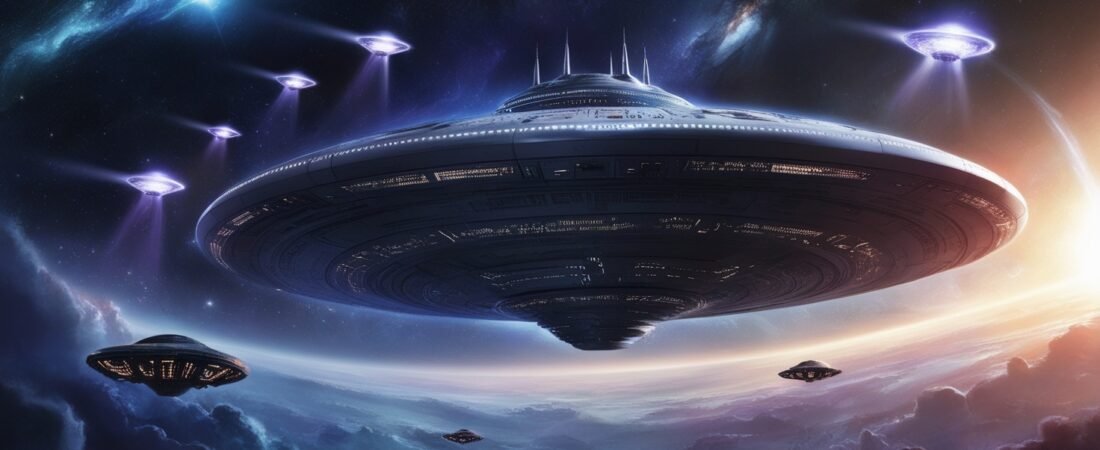Listen on Spotify
Listen on Apple Podcasts
Alien Motherships: Could We Be Under Interstellar Surveillance?
In recent years, the surge in unidentified flying object (UFO) sightings has reignited global curiosity about extraterrestrial life. Speculation reached new heights when the Pentagon released a research document suggesting that an alien mothership might be observing us from beyond our solar system. This groundbreaking theory, supported by insights from Harvard astronomers and Pentagon officials, challenges our understanding of the cosmos and raises profound questions about humanity’s place in the universe.
The Theory of Alien Motherships
The Pentagon’s research, co-authored by Sean Kirkpatrick, director of the All-domain Anomaly Resolution Office (AARO), and Abraham Loeb, Harvard University’s astronomy department chairman, explores the possibility of interstellar objects acting as parent crafts. These crafts could deploy small probes to study Earth and other planets, functioning similarly to NASA’s exploratory missions. The interstellar object 'Oumuamua, discovered in 2017, serves as a prime example. With its unusual characteristics and trajectory, some scientists speculate it could be an artificial object sent by an extraterrestrial civilization. The theory posits that such a craft could release tiny probes undetectable by existing telescopes.
The Role of the All-domain Anomaly Resolution Office (AARO)
Established in July 2022, the AARO plays a pivotal role in investigating unidentified aerial phenomena (UAPs) across air, sea, space, and cyberspace. Under Sean Kirkpatrick’s leadership, the office aims to promote transparency and reduce the stigma associated with UFO sightings. By integrating advanced surveillance and scientific analysis, AARO seeks to uncover the truth behind these enigmatic phenomena. Congressional support has been crucial, with lawmakers advocating for full funding to ensure AARO achieves its mission.
Historical Context of UFO Sightings
The fascination with UFOs dates back decades, with notable incidents like the 1947 Roswell crash sparking widespread interest. Some theorists suggest that extraterrestrial monitoring intensified after the advent of nuclear technology during World War II, when unusual radiation patterns in Earth’s atmosphere may have drawn the attention of alien civilizations. Reports of UFOs exhibiting advanced technology and illogical flight patterns have added credibility to these claims, fueling debates about their origin and purpose.
Scientific Debates and Skepticism
While the idea of an alien mothership is captivating, the scientific community remains divided. Abraham Loeb’s hypothesis has garnered significant attention, but many experts caution against jumping to conclusions. Some researchers argue that objects like 'Oumuamua could have natural origins, while others propose terrestrial explanations for UAPs. The energy requirements for interstellar travel and the constraints of Einstein’s theory of relativity also challenge the feasibility of such extraterrestrial missions.
Ethical and Practical Implications
If alien motherships are monitoring Earth, humanity faces profound ethical and practical questions. What would be our response to confirmed extraterrestrial contact? How might such a revelation affect global society, politics, and religion? Moreover, the potential for advanced technology raises concerns about its application—whether for peaceful exploration or more ominous purposes.
Public Reaction and Cultural Impact
Public reactions to the possibility of alien motherships range from excitement to skepticism. Enthusiasts see it as validation of long-held beliefs in extraterrestrial life, while skeptics demand concrete evidence. The topic has permeated popular culture, inspiring movies, books, and debates. The Pentagon’s openness in discussing these phenomena marks a significant shift, moving the conversation from conspiracy theories to mainstream scientific inquiry.
Conclusion
The idea of alien motherships and interstellar surveillance challenges our understanding of reality and fuels humanity’s innate curiosity about the unknown. While definitive answers remain elusive, the efforts of organizations like AARO reflect a commitment to exploring these mysteries with scientific rigor. Whether these sightings are natural phenomena, advanced terrestrial technology, or evidence of extraterrestrial life, the quest for truth continues to inspire awe and wonder. As we gaze into the cosmos, we are reminded that the answers to humanity’s greatest questions may lie just beyond our reach.

